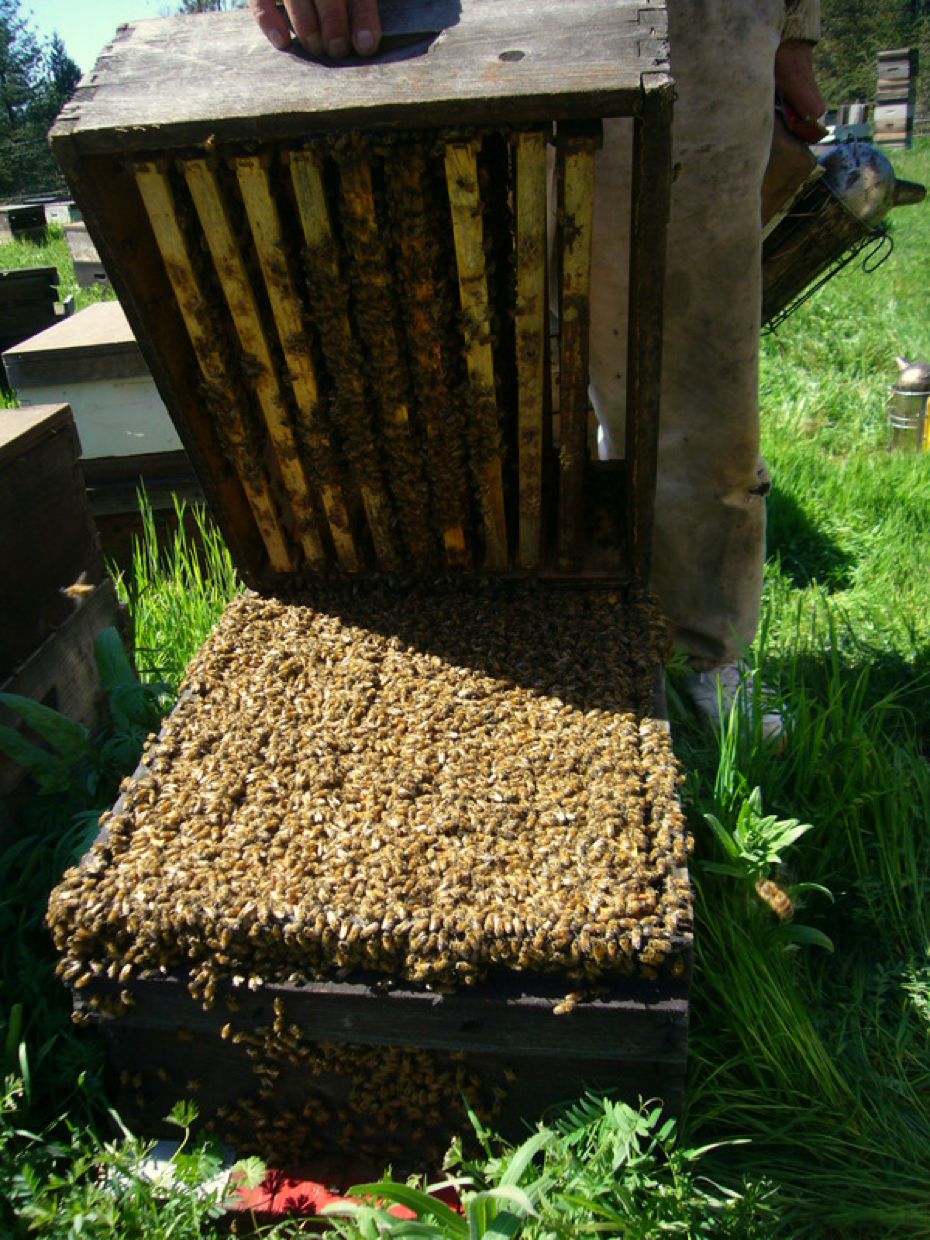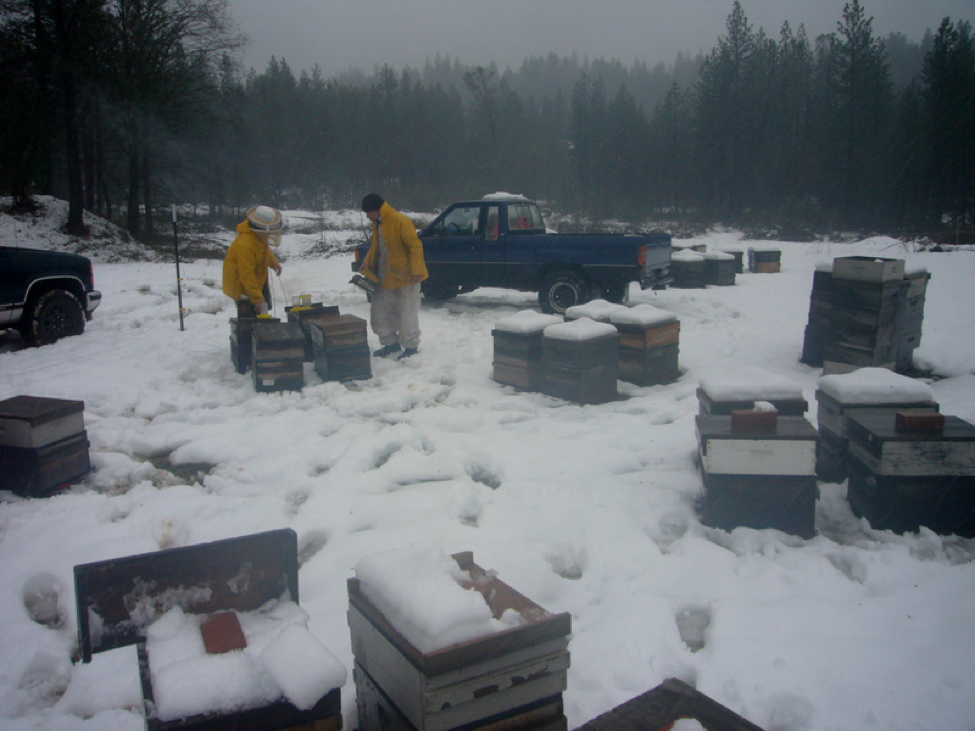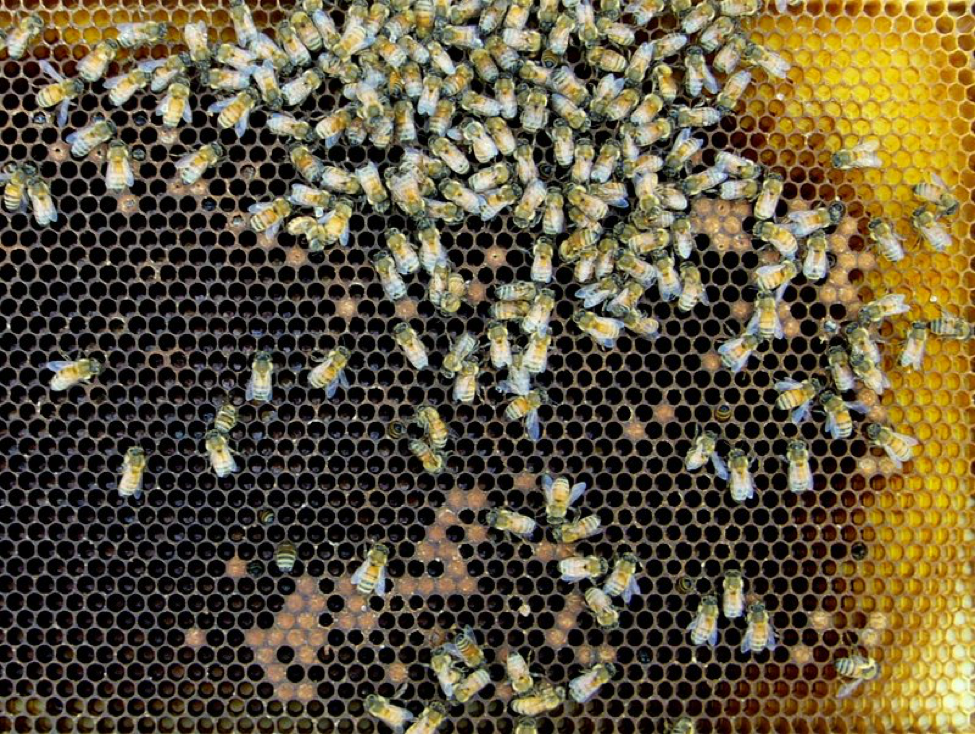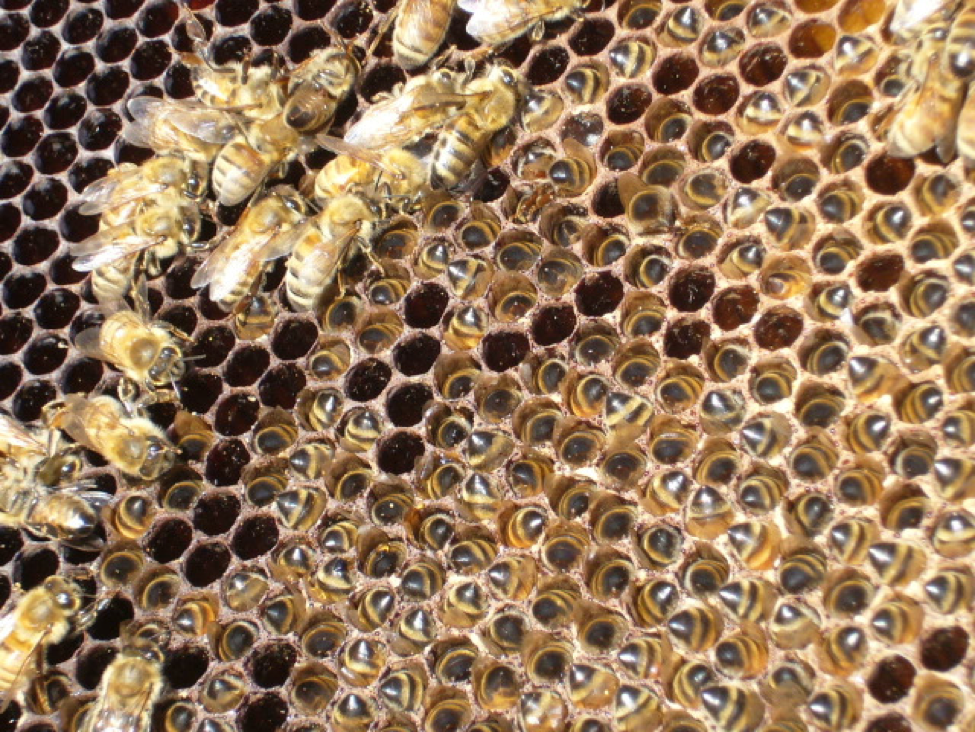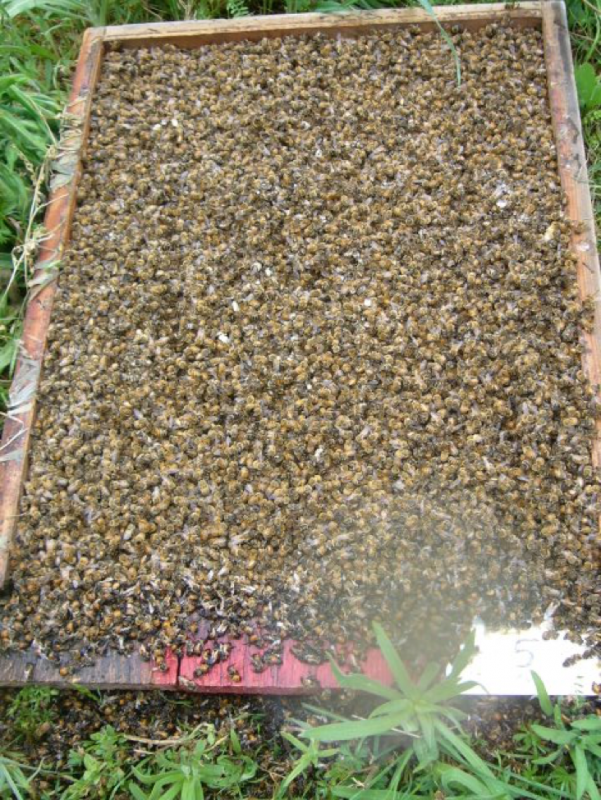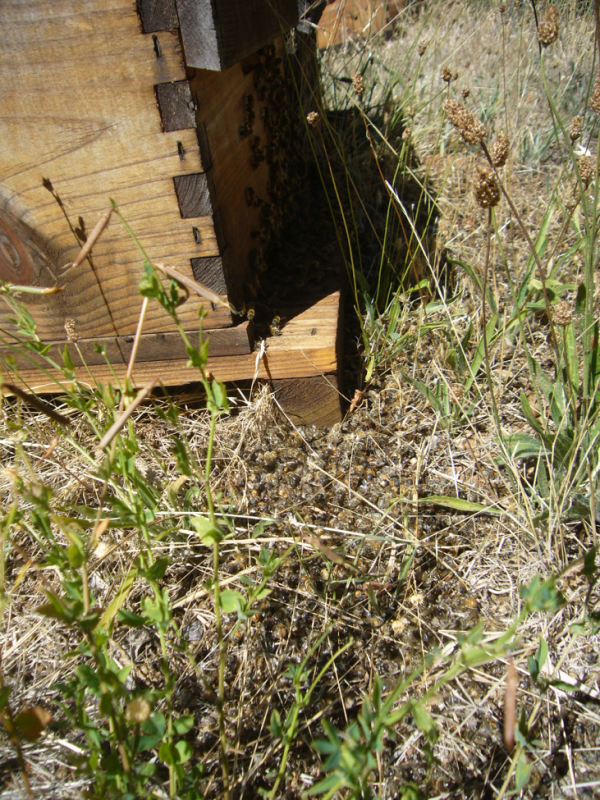Understanding Colony Buildup and Decline: Part 6 – Hiccups in Colony Linear Buildup
Understanding Colony Buildup and Decline – Part 6
Hiccups in Colony Linear Buildup
Randy Oliver
ScientificBeekeeping.com
First Published in ABJ in July 2015
CONTENTS
Return To Playing Catch Up
Real World Hiccups
The Effect Of Cold Weather
The Effect Of Rainy Weather
Spring Starvation
From Too Little To Too Much
Brood Survivorship
Adult Survivorship
Take Home Message
Acknowledgements
Citations and Footnotes
Under ideal conditions, colonies grow in a linear manner once the broodnest is well established. But ideal conditions don’t always occur in the real world. By being aware of factors that may reduce the rate of colony buildup, the beekeeper may be able to intervene and get the colony back on track.
Return To Playing Catch Up
Creating a mathematical model for colony buildup and decline is not a mere academic exercise–it has great practical application. When you attempt to create a mathematical model, you quickly find out which critical elements you don’t fully understand.
Practical application: in my own case, my newfound understanding of exactly why weak colonies are able to catch up in size with stronger colonies helps me to better grasp why springtime splits have the potential to grow as large as established colonies. Ideally, I want to split my colonies small enough to keep them from swarming, but large enough that they can build to optimal honey-producing strength.
But when I was faced with my sons’ questions as to what is the ideal amount of brood and adult bees to put into each split, I realized that I couldn’t honestly answer with certainty. So I spent considerable time in creating a spreadsheet to calculate the growth of nucs dependent upon those variables (as well as temperature and quality of the queen). I’m currently testing that model by carefully tracking the individual buildup of nucs in a test group specifically created with different measured amounts of brood and bees. I’ll let you know when I get the results.
Real World Hiccups
I find the modeling of colony growth under ideal conditions to be mathematically elegant. But of course in the real world, conditions are often less than ideal. Any number of transient phenomena can handicap colony growth, or thwart it altogether. So let’s take another look at the hiccups in growth exhibited by Harris’ colonies in my colorful chart of colony demographics (Fig. 1):
Figure 1. Note the three instances (in mid May, early and late July) in which broodrearing was curtailed, leading to hiccups in the expected linear growth of the colonies [[i]]. I’ve indicated on this graph the timing of a spring cold snap, as well as the main honeyflow.
[i] These hiccups in egglaying are broken out by individual queen in Fig. 1 of my previous article
So what caused those sudden reductions in egglaying?
The Effect Of Cold Weather
I searched the weather history for Manitoba during the period of time during which Harris collected his data. It appears that the first dip in egglaying occurred during a cold snap in early May, right during the critical “spring turnover.” The cold weather would have precluded foraging for pollen, and the freezing nighttime temperatures (15°F) would have forced the tiny clusters (averaging only about 7000 adult bees—less than 4 frame’s worth) to contract tightly—thus limiting the amount of comb suitable for broodrearing.
Practical application: cold nighttime temperatures are a major limiting factor for the buildup of small colonies, since they must go into tight cluster, which severely limits both the size of the broodnest, as well as the number of bees available for nursing duties (since the majority must be engaged in forming a heat-generating “insulating shell”).
The Effect Of Rainy Weather
April showers may bring May flowers, but even a single day of rainy weather may have a profound effect upon a growing colony. In a meticulous and intriguing study from the lab of Austrian bee researcher Karl Crailsheim [2], a rain machine was used to prevent the bees in an observation hive from foraging for only a single day at time, while keeping the inside temperature constant. What they found was that:
During rainy periods nurses spent less than half as much time nursing brood as they did during sunny periods. Our experiment suggests that the activity of the nurses is linked to the influx of food and its passage from bee to bee. Nurses receive food more often and over a longer period on days with good weather conditions than on days with bad weather conditions… It seems that the flow of nectar diminishes after only one night and causes the decline in nursing activity even on the first day with bad weather conditions and the following night.
Wow, even a single day of rain cuts nursing visits to brood by half! The researches didn’t make observations on what happened during longer storms, but I have. After about three days of rainy weather, a rapidly-growing colony will have completely depleted its pollen stores, and begins to go into protein deficit, forcing the nurses to start using their body reserves (in their fat bodies). And then it may get worse…
During prolonged rainy weather, a colony may shift from rapid growth to cannibalism of the brood within a matter of days. Such an unexpected disaster hit us hard a few years ago. In the photo below, we were adding second brood chambers to strong singles on a nice nectar and pollen flow in mid May, right at the beginning of our main honey flow (Figs. 2-5).
Figure 2. In mid May 2011, our colonies were rapidly building during our spring flow, and we had recently added the second brood chambers for them to move into, with the expectation that they’d be quickly filled with brood and honey. This was beekeeping at its best!
Figure 3. We were running an experiment at the time, and I happened to take a photo of a typical brood frame. Note the reserves of honey and beebread present on May 10th. A few days later the colonies were shaking nectar and whitening wax.
Figure 4. We live in the mountains, where the weather is rapidly changeable. We got hit by a surprise snowstorm on April 25. All photos were taken in the same yard.
Figure 5. Within four days, the hungry colonies had consumed all honey reserves and all pollen reserves. They then desperately started cannibalizing the brood–first the eggs, then young larvae, then older larvae. They don’t normally cannibalize sealed brood, since it no longer needs to be fed, and those pupae may be the colony’s only chance for survival.
We donned our cold weather gear and madly fed syrup. We were able to avert major brood cannibalism in most of our colonies, which quickly recovered when the weather turned back to warm. But those colonies that were forced to cannibalize their brood got set back so hard that they were unable to even put on winter stores during the main flow, and needed to be fed later in the season.
Practical application: someone incredulously asked me, do you really go out and feed bees during miserable weather? I answered, Well, duh, ‘cuz during good weather they’re able to feed themselves–that’s why we are called bee keepers.
Such brood cannibalism [3], albeit less dramatic, frequently occurs in my area during the two week pollen and nectar dearth that we typically experience between the end of apple bloom and the beginning of the late spring flow. I often observe plenty of freshly-laid eggs each day, but the nurses apparently eat them up rather than trying to feed larvae when there is not enough protein coming in.
Practical application: the main determinant of the development of a busting colony for honey production is having a steady supply of pollen and nectar coming in during the period beginning 6-8 weeks before the start of the main flow. It is during this time that the feeding of pollen sub can be of great benefit during periods of inclement weather or pollen dearth (as occurs in my area immediately after the end of fruit bloom).
Spring Starvation
In my area, other than during storms or the two-week post fruit bloom dearth, there is usually plenty of nectar and pollen coming in during springtime, and we rarely need to feed our splits. But from time to time, we must perform emergency feeding of the ravenous growing colonies. In the case of the colonies in the experiment shown in the photos above, I could not get approval to break protocol and feed the hives during the storm (despite my daily entreaties). The result was that a number starved on the fourth night (Figs. 6 & 7).
Figure 6. It breaks my heart to see a vigorous young colony starve to death, as indicated by the heads buried in the cells.
Fig. 7. After 4 days of bad weather, many of the colonies in the experimental yard succumbed to starvation. It was heartbreaking and ugly–this is a view of a typical bottom board. This disaster could have been easily averted by the feeding of a few dollars worth of sugar in any form.
I’ve also seen similar starvation of my strongest colonies during almond bloom if the weather turns foul. Many’s the time that I’ve dumped granulated sugar over the combs (if I didn’t have syrup with me) in order to save a colony. One time, all it took was a can of soda pop poured over the immobile bees to give them enough energy to move onto some swapped frames of honey.
During intermittent nectar dearths, colonies lacking adequate honey reserves can suffer minor starvation events. Unless you are closely monitoring the yards, all that you may see is a handful of dead bees in front of the hive, and if there has been a resumption of the nectar flow since the brief dearth, you may not be able to figure out what caused the kill (Fig. 8).
Figure 8. A “minor” starvation event occurred in this outyard in late June during a brief break in nectar availability. No colonies died, but similar to this one, most had a small pile of dead bees in front (this occurred in an area far from any pesticide applications). Only by checking the age structure of the remaining brood was I able to figure out what had gone wrong, since by the time I took this photo the colonies had replenished their nectar stores.
Practical application: during these recent drought years in California, we can no longer count on our normal nectar flows. This spring has been scary—our colonies have repeatedly been on the edge of starvation, since we kept expecting the “normal” nectar flows to kick in. As I type these words, I’m starting to resign myself to the possibility that the main flow is simply not gonna happen, and that I am going to be forced to spend a fortune on sugar in order to keep my colonies alive.
It’s clear that a shortage of nectar/pollen (even due to a few days of rain) can bring recruitment to a temporary halt; conversely, a surfeit can also do the same…
From Too Little To Too Much
A nice nectar and pollen flow is extremely stimulating to broodrearing. But on the other hand, too much nectar or pollen can result in the bees plugging the broodnest, filling comb that the queen would normally fill with eggs (Fig. 9).
Figure 9. A brood comb following favorable weather in almond bloom. The past few years we’ve had great foraging weather during almond bloom, sometimes resulting in the broodnests getting plugged out with pollen and nectar. Since the queen can’t find a place in which to lay eggs, there will little recruitment of emerging workers three weeks later, and colony populations may temporarily dwindle, much to the dismay of those beekeepers needing to shake packages or make splits.
Practical application: during spring buildup, it may be necessary to either reverse the brood chambers, or to add drawn comb to the broodnest to give the queen additional room in which to lay.
Tip for beginners: excessive feeding of syrup to colonies can also cause plugging out of the broodnest, leading to swarming in the spring, or poor wintering in the fall (due to lack of broodrearing at the end of the season).
Brood Survivorship
Keep in mind that colony buildup is all about the difference between the rates of recruitment of new workers and the rate of attrition of older workers. Pathogens that affect the brood reduce the rate of recruitment. When I began beekeeping, AFB was the only brood disease that we worried about—chalkbrood had yet to reach our shores, and EFB would go away on its own once a good nectar flow resumed. Nowadays, I rarely see AFB. What I do see in spring is persistent EFB (Fig. 10), and sometimes other unidentifiable brood diseases [4].
Figure 10. European Foulbrood can bring colony buildup to a screeching halt by decreasing the rate of larval survival. The larvae in this photo are clearly symptomatic, but in many cases are difficult to detect. Unlike the EFB of yore, today’s EFB may not clear up without treatment.
Although I don’t see much chalkbrood any more, a few years ago I visited apiaries on the East Coast in which chalkbrood was running rampant, preventing colonies from building up. And it is not just pathogen-caused brood disease that may cause a problem. Toxic pollen (such as that of California Buckeye), nutritionally inadequate pollen, smokestack pollution, chilling of the brood due to anything that causes high adult mortality (virus, nosema, pesticides), or pesticide/miticide residues can all affect the colony similarly, in that they may reduce larval survivability.
Practical application: any factor that reduces larval survivability (such as chilling, poor nutrition, toxins, or disease) will decrease the rate of recruitment, and have a profound effect upon not only the rate of colony buildup, but unless the problem is resolved, also upon its ultimate population size.
Adult Survivorship
The rate of colony buildup is also determined by the rate of attrition of the adult bees. Ideally, springtime workers can be expected to live for an average of about 35 days. During spring buildup, adult survivorship is critical to colony success. I find that infection by either viruses or nosema can prevent a successful spring turnover due to their decreasing adult survivorship [5].
It doesn’t take much of a reduction in adult survivorship to exhibit a profound effect (Fig. 11):
Figure 11. In order to create this graph, I shifted Harris’ survivorship curves either longer or shorter by 5 days (roughly a 14% increase or decrease in average survivorship). Note how even a few days increase or reduction in average worker longevity has a profound effect upon colony buildup and eventual maximum population.
Practical application: any factor that negatively affects either larval or adult worker survivorship can make a huge difference in eventual colony size and honey production.
Take Home Message
Once a broodnest is established and the population has grown to the extent that the queen can hit her stride in egglaying (which takes a cluster covering at least 7 frames), the honey bee colony has the potential to grow at a linear rate of increase of nearly 2 frames of bees per week. But things don’t always go well for growing colonies. As beekeepers, we can provide husbandry to minimize any breaks in the momentum of colony buildup, as well put by Jeffrey in 1959 [6]:
…in Britain colonies are ordinarily increasing in size for only about three months out of the twelve, and in late summer and throughout the long autumn, winter and early spring, numbers are steadily declining This would apparently point to two important principles in commercially successful bee-keeping: first, that the bee-keeper ought to guard carefully against any break in that swift and steady upward surge in the number of bees during April, May and June—for a break at this time cannot be fully retrieved later—and in particular it is suggested that queenless intervals should be most carefully avoided; and secondly, steps should be taken to reduce to a minimum the rate of decline during those other nine long months.
Next month: I’ll continue with the swarming impulse
Acknowledgements
As always, my thanks to Lloyd Harris and Peter Borst.
Citations and Footnotes
[1] These hiccups in egglaying are broken out by individual queen in Fig. 1 of my previous article
[2] Riessberger U, & K Crailsheim (1887) Short-term effect of different weather conditions upon the behaviour of forager and nurse honey bees (Apis mellifera carnica Pollmann). Apidologie 28: 411–426. Open access.
[3] Schmickl T & K Crailsheim (2001) Cannibalism and early capping: strategy of honeybee colonies in times of experimental pollen shortages. J Comp Physiol A 187(7):541–547.
[4] For symptoms of some of the “new” brood diseases, see https://scientificbeekeeping.com/sick-bees-part-18a-colony-collaspse-revisited/
[5] See Figure 11 in Part 3 of this series.
[6] Jeffree, EP (1959) Op cit.
See also Jeffree, EP (1955) Observations on the growth and decline of honey bee colonies. Journal of Economic Entomology. 48: 732-726.
Tags: adult survivorship, brood survivorship, cold weather, rainy weather, spring, starvation





